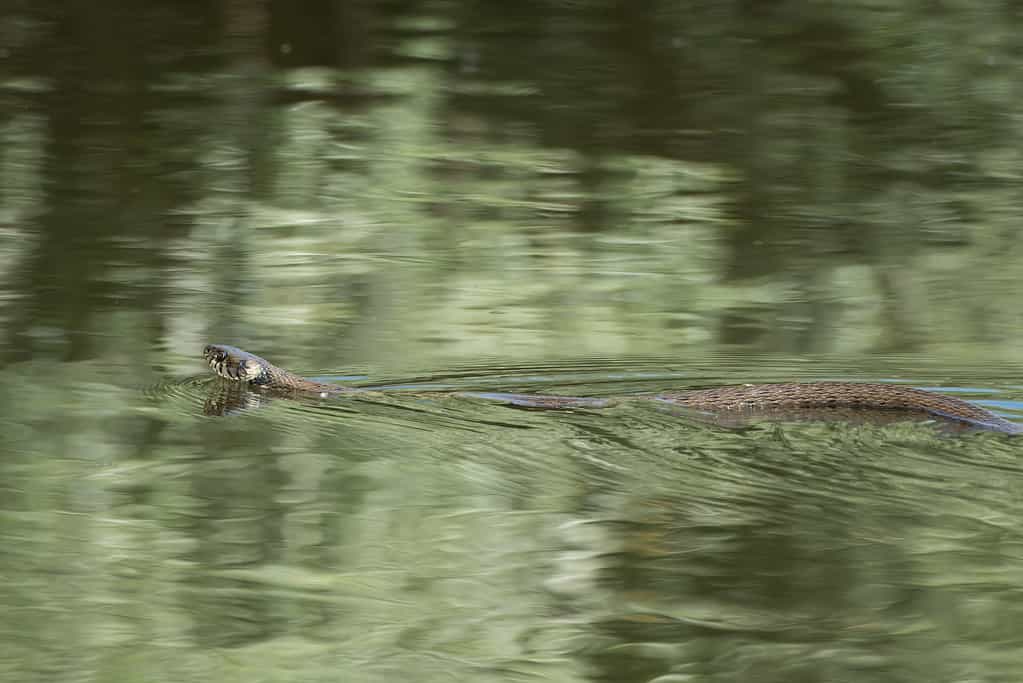Snakes are remarkable creatures, having adapted to diverse environments with a variety of survival strategies. However, when it comes to whether or not snakes breathe underwater, the short answer is no. Snakes are simply not equipped to extract oxygen from water in order to breathe.
To understand why snakes can’t naturally breathe underwater, we need to first have a look at their respiratory system. Like all reptiles, snakes breathe using their lungs. But unlike fish, which have gills for extracting dissolved oxygen from water, snakes primarily rely on lungs for breathing.
The elongated lungs of a snake run almost the entire length of their body. This provides a considerable surface area for gas exchange. The unique design allows snakes to extract oxygen from the air. But this also means that snakes cannot extract oxygen directly from water. Again, they are not like fish, who use their gills to breathe.
How Snakes Stay Submerged in Water
While snakes lack the same ability as fish to breathe underwater, they are exceptionally adaptable and resourceful. Some species of snakes have developed unique behaviors and anatomical features that enable them to stay underwater for long periods of time — even though they cannot actually breathe underwater.
One example is the anaconda, the largest snake in the world. Anacondas are proficient swimmers and spend a significant amount of time in the water. They have specialized nostrils and valves in their respiratory system that allow them to remain partially submerged while still being able to breathe. The anaconda can expose its nostrils above the water’s surface while the rest of its body remains submerged. This is what makes it possible for them to stay mostly hidden underwater.

The anaconda can stay submerged for long periods of time, but it can’t breathe underwater.
©Utopia_88/ via Getty Images
Another interesting adaptation can be found with the sea snake. While not strictly “breathing underwater” in the traditional sense, sea snakes are highly adapted to marine life. They have a special gland in their mouth that allows them to excrete excess salt ingested from seawater. And sea snakes can also absorb oxygen through their skin to a certain extent. This allows them to stay submerged longer so they can venture into deeper waters in search of prey.

The sea snake is an incredible swimmer, but it can’t breathe underwater.
©richcarey/ via Getty Images
Like sea snakes, water snakes are highly adept swimmers with streamlined bodies. These physical characteristics allow them to navigate through water with minimal resistance. Their scales are often keeled, which provides more surface area for efficient movement through the water. They will also submerge themselves for extended periods of time, patiently waiting for prey to approach.
Other Aquatic Adaptions
Many aquatic snake species are also ectothermic, which means they rely on external sources of heat to regulate their body temperature. This is why you’ll often find aquatic snakes basking in the sun on rocks or other surfaces near the water. These snakes can actually elevate their body temperature. Which, in turn, enhances their metabolic processes and overall activity level.

The water snake has keeled scales, making it an efficient swimmer.
©Witold Siekierzynski/ via Getty Images
Some species of aquatic snakes give birth to live young instead of laying eggs, a reproductive strategy known as viviparity. This adaptation helps their young survive in aquatic environments because it allows the mother to provide protection to her offspring. It also helps increase the chances of their survival in water.
It’s crucial to note that these adaptations are more about surviving in aquatic environments. Snakes cannot breathe underwater and are still reliant on air. Their ability to stay submerged is a result of unique behaviors and anatomical features that allow them to navigate and hunt in water.
The photo featured at the top of this post is © tornado98/ via Getty Images
Discover the "Monster" Snake 5X Bigger than an Anaconda
Every day A-Z Animals sends out some of the most incredible facts in the world from our free newsletter. Want to discover the 10 most beautiful snakes in the world, a "snake island" where you're never more than 3 feet from danger, or a "monster" snake 5X larger than an anaconda? Then sign up right now and you'll start receiving our daily newsletter absolutely free.
Thank you for reading! Have some feedback for us? Contact the AZ Animals editorial team.






